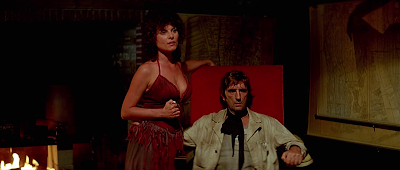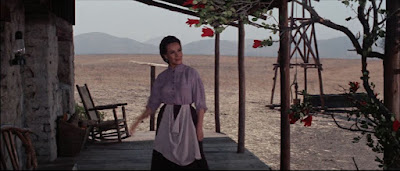Oh yes, the cruel future we forecast for ourselves was way more entertaining back in 1981 than it’s turning out to be and the older this film gets, the more youthful and relevant it appears. As we piled off the bus, probably bunking off school, to see this in Liverpool’s old ABC in Lime Street, it was all of a piece with Planet of the Apes, Logan’s Run and Soylent Green, dark and violent entertainments providing a warning of worlds we just assumed we’d never see. John Carpenter thought differently and made his futuristic 1997 as grimy and real as he could, just a president away from societal breakdown.
And, in these times of trouble it takes a very special man to navigate the brutal streets, gangs and faithless government and such a men is Snake Plissken played by a pumped-up Kurt Russell with a swagger and edge that few could rival before or since. This is a dystopian High Noon or before that Hells Hinges (1916, William S Hart, look him up…) in which a single individual is all that stands between humanity’s disaster and the smallest shard of hope.
Written and directed by John Carpenter who also provides a score – composed with Alan Howarth – with stygian synthesised sweeps that help establish an oppressive and alienated feel to a world in which almost no one can be trusted least of all authority although the alternatives are just as bad. Snake is possibly the only man we can rely on, although even then we’re not sure. He’s an anti-hero and like it or lump it, our only way in or out of Carpenter’s intended message.
 |
| New York City sometime soon |
In 1988 the crime rate in the US rises by 400% and the powers that be decide that the only way to cap this lawlessness is to set up the island of Manhattan as the highest security prison imaginable. They build a wall around it and a security monitoring station of Liberty Island… see what they did there? – and it’s impregnable which is a shame for the millions of inmates but especially so when the President’s plane is hijacked and destroyed whilst his escape pod lands right in the middle of downtown.
The President (Donald Pleasence) has a briefcase handcuffed to his hand which contains a tape to be played at a peace summit to hopefully stop America’s ongoing conflict with China and Russia… the stakes could not be higher and yet when Police Commissioner Bob Hauk (Lee Van Cleef) sends in squad, the President has been captured and they are told he will be killed if they don’t leave immediately.
As luck would have it, former special forces Lieutenant, S.D. "Snake" Plissken (Kurt) is being processed before being sent to Manhattan after trying to liberate funds from the Federal Reserve. Hauk makes him an offer he can’t refuse – a full pardon plus an injection that will detonate within 24 hours – and sends him in via a glider the one-eyed veteran has to land on top of one of the Twin Towers… The film is ripe with such moments of contemporary poignance. The shots of a darkened New York are still very effective and some of the matte paintings were done by James Cameron, who was working as a special-effects artist at the time.
 |
| Lee Van Cleef |
In goes Snake and after finding the missing Presidential Pod, encounters a friendly "Cabbie" (Ernest Borgnine) who recognises him and offers to help. Ignoring this advice Plissken plods on only to find that New York is a tough old town and if you can make it there you can make it anywhere… Talking of show tunes, Cabbie loves them and as he rescues Snake from a riot, he plays some good old tunes as he take shim to meet former compadre Harold "Brain" Hellman (Harry Dean Stanton) and his partner Maggie (Adrienne Barbeau, who was the highlight of many a teenage cinematic afternoon).
They know who has the President, it’s The Duke (Isaac
Hayes who is definitely not walking on by here) who rules much of the locale
and drives a Cadillac with candelabras on as you do. Duke’s plan is to use his
prisoner to negotiate a mass escape across the 69th Street Bridge
which isn’t going to end well for anyone and Snake certainly doesn’t have the
time. He persuades the three to help him assuring them of clemency if they
succeed.
They set off for Duke’s headquarters at Grand Central Station where Snake gets shot in the leg and captured whilst Brain and Maggie make off with the President. Carpenter used St Louis’ Central Station as the location for Duke’s base and it’s a very convincing double as Snake is made to fight the giant Slag (professional wrestler Ox Baker) in a boxing ring surrounded by Duke’s hoards; it’s not looking good for our limping anti-hero. There’s many twists and turns to come though and who’s going to bet against Plissken, especially when you know there’s a sequel!

Adrienne Barbeau and Harry Dean Stanton
Dusty Verdict: Escape from New York holds up well after all these years and that’s down to Carpenter’s ability to build and maintain tension as well as create such tangible atmospherics. The filming was mostly during the nighttime and the director said that he didn’t see daylight for two and a half months. This made the most of the St Louis locations as well as creating that suffocating oppressed “Manhattan”.
Kurt Russell is of course magnificent and relishing the chance to break away from the more conventional roles that he had built his initial success upon. He’s in peak physical condition here and mostly in character throughout the shoot as the man who lives just for the moment, and certainly this can be read as one of Carpenter’s main messages along with don’t trust the Government… he was inspired by the events of Watergate.
Which pretty much brings us full circle to where we are almost at now…
 |
| Isaac Hayes, Harry and Adrienne |







































